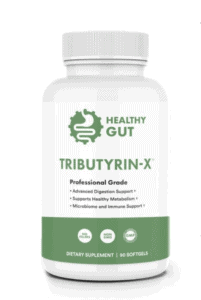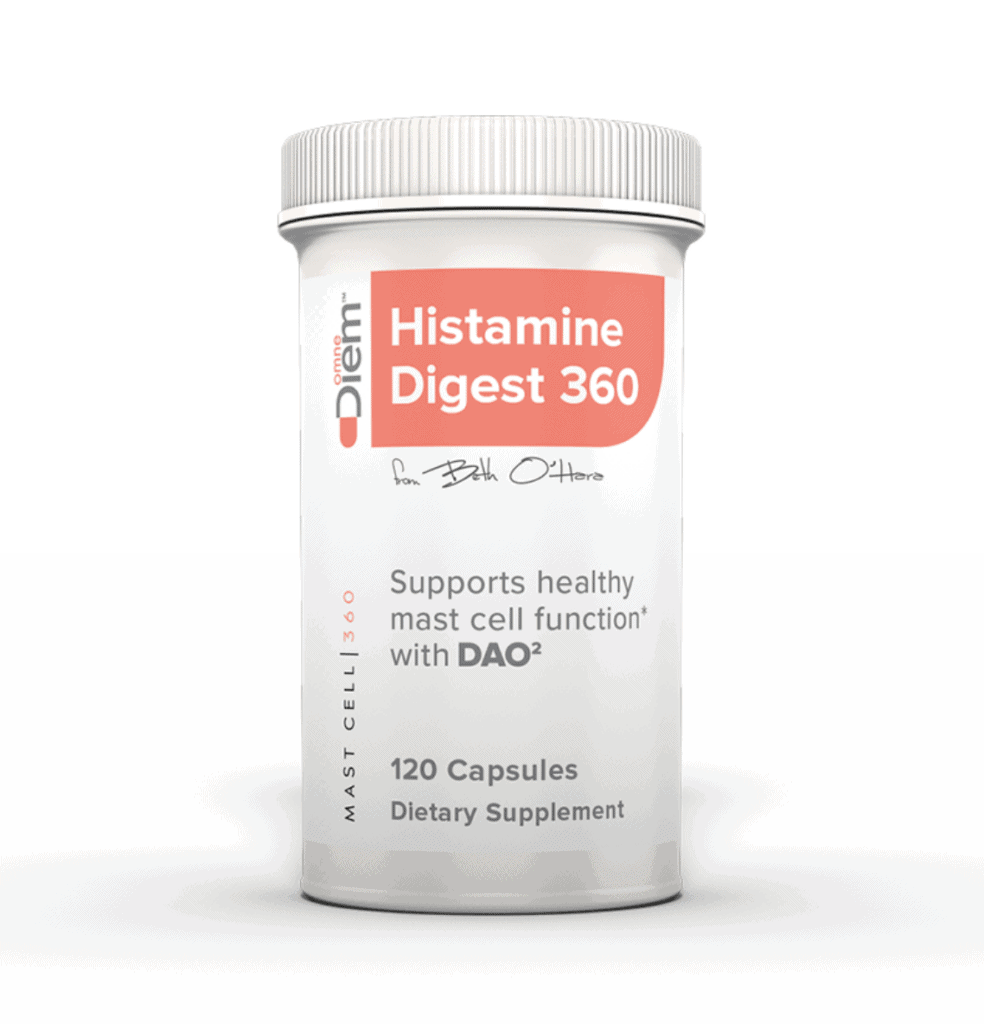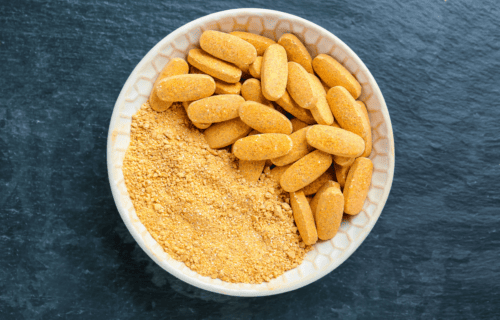
Managing Histamine, Salicylate, and FODMAP Intolerance with Mast Cell Activation Syndrome and Histamine Intolerance
If you’re like most of us with Mast cell Activation Syndrome or Histamine Intolerance, you probably have your own list of gut symptoms.
Mine were often embarrassing. A few years ago, I celebrated my 40th birthday. I was so excited to go out with my friends!
The night was going to start with dinner out. I’d picked the restaurant carefully to make sure there were gluten-free, dairy-free, low histamine options for me. And I wore a new cute dress I’d picked out just for the occasion. I felt really good in it!
But sometimes, no matter how carefully I ate, my gut just didn’t feel right. And that was one of those times. After dinner, I started having pain and felt gassy.
That was definitely not ideal for a big celebration night. 😏
I tried not to let it keep me from having a good time. But it did affect the quality of my night. And later, when I saw the pictures of us taken after dinner, I wanted to cry. I was so bloated. I looked 6 months pregnant in my cute new dress.
At least it was a stretchy dress!
My health was so much better by the time I turned 40. But my gut remained my weakest spot for years.
Gut problems are common for those of us with Mast Cell Activation Syndrome or Histamine Intolerance.
We don’t always like to talk about them. In fact, we might go out of our way to hide some of them. But that only leads to more discomfort.
And really, it’s important to not hide from these issues. We are all human. And good digestion and elimination are important to our health.
Yes, it can be embarrassing to be at work or out with friends only to start experiencing gas!
And what about diarrhea? If you’ve ever had to deal with this while out in public, you’ll know exactly what I mean. All your thoughts become centered around the bathroom.
Is there a bathroom available? Will I be able to get there quickly? Did anyone hear the sounds coming from my stall? I know that last question may seem a bit silly to someone who doesn’t have these issues. But when you’re in pain and discomfort, it feels like a big deal!
But if you have gut issues, I want you to know that you aren’t alone. About 80% of the people I see in the Mast Cell 360 practice experience gut problems.
Gut problems can present in several different ways. Most commonly you’ll experience them as:
- Constipation
- Diarrhea
- Gas
- Bloating
- Food Intolerances
These symptoms are how most people know they have gut problems. But what causes those gut problems can be complex.
Eating a clean diet can certainly help and make a difference in gut problems. But many of us are dealing with so much more.
Gut issues can stem from any one or more of the following:
- a gut biome that is out of balance
- SIBO (Small Intestinal Bacteria Overgrowth)
- SIFO (Small Intestinal Fungal Overgrowth)
- low stomach acid
- poor digestion
- mold toxins dumping into the gut
- nervous system dysregulation
and that’s just to name a few.
Regardless the cause of your gut issues, you’ll want to address them. These symptoms are your body saying it needs help.
So what do you do when cleaning up your diet isn’t getting your gut better?
There are a number of steps that may be needed.
One of those steps might be to start looking a little deeper into the digestive process. This includes how the body breaks down food and eliminates waste. Digestive enzymes play a key role in that process.
And lots of issues can occur when those digestive enzymes aren’t doing their job.
So, let’s start by looking at digestive enzymes and why they are important.
What are Digestive Enzymes? – What to know if you have Mast Cell Activation or Histamine Intolerance

It’s important you know that this blog post is for informational and educational purposes. It’s not meant to treat any health condition or to be prescriptive for anyone.
First, you might be asking: What are enzymes? Sure, you’ve heard that word before, but what are they exactly?
There are many different types of enzymes in your body.
Digestive enzymes are just one kind of enzyme. They’re extremely important to life. It’s almost impossible to thrive or have good health without them.
Enzymes have many roles. One role is speeding up processes. They can speed them up from between 100 million to 10 billion times!
But why is speeding up processes important to digestive health?
Some people experience slow motility. That means there is an unusually slow passing of waste through the large intestine.
And if food and its waste by-products sit around in the gut longer than they should, it can be a problem. It can create an environment for bacteria to thrive. That can make for an imbalanced gut biome. And it can lead to problems like SIBO.
So, speeding up slow motility can allow your body to properly digest your food...And eliminate waste regularly. When things are moving, they aren’t creating that perfect environment for bacteria.
If you aren’t having bowel movements, digestive enzymes can help with the digestive process by speeding it up.
But some people don’t have slow motility. For some, things moving too fast. This can be a contributor to diarrhea.
Fortunately, digestive enzymes can also support your gut when you have diarrhea.
With diarrhea, you might not be absorbing nutrients from your food properly.
If your gut is inflamed or damaged, you’re not going to absorb nutrients as well.
That’s where digestive enzymes come in. They can greatly improve your ability to break down food and absorb nutrients.
That means they can help you get more nutrition out of what you eat.
Digestive enzymes can be helpful for Mast Cell Activation or Histamine Intolerance, too. This can happen by supporting the reduction of any kind of inflammation in the gut that can trigger Mast Cells.
Plus, if you’ve been reading the Mast Cell 360 blog, you know that the nervous system and mast cells are closely linked.
But did you know that a lot of the nervous system is found in the gut? And did you know mast cells are found in the entire gut?
So, with poor digestion, you have an upset gut. And because a lot of the nervous system is found in the gut, an upset gut equals an upset nervous system.
And an upset nervous system equals upset mast cells.
So, when you improve digestion, you improve your gut health. And that means improvement in your nervous system.
And that equals happier mast cells.
So, we’ve looked at how digestive enzymes can help in Mast Cell Activation and Histamine Intolerance.
Next, let’s look a little more into what kinds of enzymes help with digestion.
Pancreatic enzymes do a lot of digestive work. They help break down fats, proteins, and carbohydrates. Pepsin, a stomach protein enzyme, is another. It digests proteins.
Brush border enzymes are another important enzyme. They are made in the small intestine. Their job is to finish breaking down food particles.
Brush border enzymes clean up all the leftover junk and make it usable by the body. And whatever is being used by the body isn’t left sitting around for bad bacteria to feed on. That helps keep the gut biome in check.
You need both pancreatic enzymes and brush border enzymes for good digestion.
But sometimes those digestive enzymes your body makes might need some extra support.
You’re more likely to need digestive enzyme support if you have these kinds of issues:
- Mold Toxicity
- SIBO
- SIFO
- Gut Mast Cell Activation (causing inflammation)
- Food Intolerances
These things can all create more inflammation in the gut. This then reduces your gut’s ability to make digestive enzymes.
This is also why Food Intolerances can become a vicious cycle. The more your gut is inflamed, the fewer enzymes you can make. And with few enzymes, you can’t break down histamines, FODMAPs, or salicylates properly.
If you’ve tried cleaning up your diet and you’re still have digestive issues, you’ll want to look into whether digestive enzyme supports are right for you.
But next, let’s look deeper into how this affects different types of food intolerances.
Digestive Enzymes & Histamine, Salicylate, and FODMAP Intolerances – What to know if you have Mast Cell Activation or Histamine Intolerance

Before you change your diet on your own, please make sure you’re working with a healthcare practitioner who can help you with this.
We’re going to look at 4 types of food intolerances here. You likely don’t have all of these. But you might be dealing with one or more. I want to share this information with you in case you have any of these.
Just please don’t limit your foods unnecessarily. And always work with a healthcare practitioner.
Let’s start with Histamine Intolerance.
Histamine Intolerance and Digestive Enzymes
Inflammation in your gut can contribute to Histamine Intolerance.
This is because the enzyme called DAO (diamine oxidase) is made in the gut lining. DAO helps break down histamine from foods. And any form of gut inflammation can significantly lower your DAO.
So supplementing with DAO can certainly help with Histamine Intolerance.
But, if you want to improve your gut longer term, you also need to improve your digestive enzymes. This is so your body can eventually make DAO again on its own.
(Of course, you also have to address any other triggers, like Mold Toxicity, for example.)
If you have Histamine Intolerance, you don’t want to overlook digestive enzyme support.
Salicylate Intolerance and Digestive Enzymes
Another food intolerance is Salicylate Intolerance. This is where the body has trouble breaking down certain types of food molecules called polyphenols.
So how do digestive enzymes play a role in Salicylate Intolerance?
Salicylate intolerance happens when you have trouble getting rid of a type of compound in plants. Specifically, these are types of polyphenols.
The get broken down in 2 ways: in the liver and in the gut. This is why Mold Toxicity can be a huge contributor to Salicylate intolerance.
We’re going to focus on the gut part today.
If the enzymes that reduce polyphenols are low, this can impair your ability to break down salicylates.
So certain foods high in polyphenols aren’t getting broken down properly in the gut.
And remember, what your gut can’t properly break down can become inflammatory and harmful.
Salicylate intolerance is rather complex.
But one specific digestive enzyme can really help with Salicylates. It’s called Xylanase.
Supplementing with xylanase likely works because it breaks down the structural components of phenols faster than would normally happen in the gut. Less time in the gut means less inflammation and less salicylates getting into the bloodstream.
So digestive enzymes containing xylanase may help with salicylate intolerance.
Next, let’s look at FODMAP Intolerance.
FODMAP Intolerance and Digestive Enzymes
Some people have trouble with FODMAPs.
FODMAP intolerance is an intolerance to certain types of carbohydrates that ferment and cause gas in the stomach. This can happen from imbalances of bacteria. It can also happen when the gut is missing enzymes.
When people with FODMAP intolerance eat certain foods, they can experience bloating, gas, and diarrhea or constipation.
So how would digestive enzymes help with this?
You need digestive enzymes to break down carbohydrates so they don’t ferment in the gut.
I’ve seen good results in dealing with FODMAP Intolerance with using a very high quality, ACTIVATED enzyme combined with a very specific enteric-coated butyrate. (More on that later).
A good quality digestive enzyme product can help break down the different types of FODMAPs so they don’t cause so many problems. And this can allow the gut to start to repair.
Specifically, these enzymes are important with FODMAP carbohydrates:
- Amylase
- Xylanase
- Cellulase
- Maltase
- Lactase
- Sucrase
Alpha galactosidase is also important in FODMAPs – it helps break down things like cruciferous veggies (ie. Broccoli, cauliflower, cabbage, brussels sprouts, etc.) as well as beans, lentils, and nuts.
But with all the different supplements out there, what should you look for when choosing a quality digestive enzyme? Let’s look at that next.
What to Look for in a Digestive Enzyme – What to know for those with Mast Cell Activation Syndrome or Histamine Intolerance
This blog post is for informational and educational purposes. It’s not meant to treat any health condition or to be prescriptive for anyone. Always work with your healthcare professional.
Whenever I need a new supplement for myself or my clients, I carefully look at each one I’m considering. I look for clean products from reputable companies.
In most cases, you’ll want to avoid getting supplements from big box stores. They keep their supplements in a warehouse without temperature control. Some supplements are heat intolerant.
And one of the biggest online shopping sites has been known to sell counterfeit supplements. That means the product you get might be very different from the product you really want! And it could be full of unwanted additives.
Another challenge with enzyme supplements is they don’t all work the same. I’ve actually tried over 20 different enzyme products. Many didn’t work very well at all.
After a lot of research and interviewing top gut experts, I learned the important qualities to look for in a good digestive enzyme:
- Includes both pancreatic and brush border enzymes
- Avoidance of common allergens like casein, soy, wheat, gluten, tree nuts, peanuts, and yeast, among others
- Strong, concentrated enzymes
- Pharmaceutical grade status
- Full pH coverage – Systemic Effective range of pH 1.7 to 11.0
- Activated with mineral cofactors (Cofactors are helpers, usually vitamins or minerals. They help get the enzymes energized to work.)
- NSF certification (highest third-party standard)
- High-quality raw ingredients
- Lack of mast cell triggering additives like titanium dioxide, talc, artificial colors or flavors
After years of trying so many digestive enzyme supports, only one of them helped me significantly with my own gut issues.
It’s called HoloZyme. It came out not too long ago, but it’s quickly become the top digestive enzyme support.
It checked all the boxes on my list of the dream digestive enzyme support:
- Blend of both pancreatic and brush border enzymes
- Mineral cofactors (470 mg per 2 servings) for activation (making enzymes work properly)
- Activation blend that’s precision tuned
- Pharmaceutical grade status with NSF certification
- High-quality raw ingredients
- No mast cell-triggering additives like magnesium stearate, silica, artificial colors or flavors
- Avoidance of common allergens
- Manufactured in the USA
And I’ve had several conversations with the formulator. I told him what people in our Mast Cell community suffer with.
So, when the new formula of HoloZyme was developed, I was so excited! The new formula has:
- 100% increase in Cellulase and 8000% increase in Xylanase (helps reduce Salicylates and FODMAP type fibers and helps with bloating)
- New enzyme formulation helps with issues eating nuts and vegetables
- 20% Increase in Protease for protein digestion
- 20% increase in Amylase for carbohydrate digestion
- 50% more Lipase for improved fat digestion power
- 82.5% reduction in iodine (kelp) content (better for sensitive people)
- 4x boost in fulvic acids and minerals to activate the enzymes so they work (this is missing in other enzyme products)
- Works equally well for both types of IBS (constipation and diarrhea types)
This enzyme also has:
- Alpha galactosidase for better FODMAP digestion (like vegetables, beans, and lentils)
- Phytase to help with nuts and seeds

Steve Wright at Healthy Gut has generously given our community
$15 off with the link below
>>>>> Click here for $15 off HoloZyme <<<<<
Discount will automatically be applied.
I’ve used HoloZyme myself for over a year now. And I’ve recommended it to many people in my Mast Cell 360 practice.
Only a very small number of clients have had trouble with this one. When someone does have trouble, it’s usually been because they are sensitive to every supplement. This is often an indicator of significant nervous system dysregulation.
It may also not be the time to try it if you are super sensitive with a lot of metal toxicity. Minerals can displace metals.
I’ll have an alternative for you in just a bit if this is the case.

>>>>> Click here for $15 off HoloZyme <<<<<
Discount will automatically be applied.
So, I can’t ever promise that any one thing will work for everyone. But if you want to try it, Healthy Gut offers a 60-day money back guarantee. It’s hard to find that in supplements!
Here are a couple of things to know if you are considering giving HoloZyme a try.
It does have a little kelp as part of the mineral cofactors. But in the new formula, the iodine (kelp) content was reduced by 82.5%. So, it is now even better for sensitive people.
It also has a little bit of magnesium citrate. I normally say to avoid citrates. But in this case, the citrates are used up by the activation process. I haven’t found it to be a problem in our population.
If you are super sensitive, you can also open the capsule on this supplement. You can sprinkle it onto food or water. Start slowly if you are sensitive. We like to say, “start with just a sprinkle” and then gradually build up if you are tolerating it.
Another important note:
Your gut health is going to change over time. Hopefully, it will improve!
That means the amount you take may need to change from time to time. For example, at first, you might need 6 enzymes per meal to really digest. But as your gut heals, you might only need 2 enzymes per meal.
Each person has to find their own optimal amount. I personally take 4-5 capsules per meal. That’s what is working for me right now.
Other people do better with 1 capsule per meal. And others may do best using 6 capsules per meal while their gut is healing.
Again, you’ll want to experiment to see what is right for you. And start very slowly.
HoloZyme is my number one choice for digestive enzymes for all the reasons I went over. It has been a major help to me and many of my clients.

>>>>> Click here for $15 off HoloZyme <<<<<
Discount will automatically be applied.
But, if you are really sensitive to the citrate or you can’t handle the HoloZyme, you might want to consider this simpler pancreatic enzyme as a starting point instead. Then as you improve, you could try HoloZyme later.
Pancreatic Enzyme
Lastly, a quick mention of the other supplement I mentioned for FODMAPs. In FODMAP intolerance, the small intestinal bacteria are also out of whack.
And this is where supporting the gut ecosystem can help. So, I like to combine HoloZyme with Tributyrin-X.
It helps with repairing the gut lining and supporting the healthy bacteria balance in your gut. It’s one of my other favorite supplements.
It can also help modulate motility – helping both constipation and diarrhea.
People with constipation usually just take 1 soft gel 1-2x/day. And people with loose stools or diarrhea usually take more – around 2 to 3 soft gels 1-2x/day.
The butyrate in Tributyrin-X is specially formulated to bypass the stomach acid and get to the small intestine — exactly where it needs to go.
I’ve also seen it help in histamine intolerance.
With this supplement, you do not want to open the capsule. Butyrate naturally has a strong smell. You might not ever try it again if you open the capsule.
It does have a miniscule amount of sorbitol that is very rarely a problem. And it also comes with a 60-day risk-free money back guarantee.

You can also get $15 off Tributyrin-X:
>>>>> Click here for $15 off Tributyrin-X <<<<<
Discount will automatically be applied.
And for those who are really, really, sensitive, you might need to start supporting your nervous system first. Getting the mast cells calmed down can help with supplement sensitivities, among other things.
I encourage you to keep taking steps toward better health. Keep going and keep hope!
*Some links in this website are affiliate links, which means Mast Cell 360 may make a very small commission if you purchase through the link. It never costs you any more to purchase through the links, and we try to find the best deals we can. We only recommend products that we love and use personally or use in the Mast Cell 360 practice. Any commissions help support the newsletter, website, and ongoing research so Mast Cell 360 can continue to offer you free tips, recipes, and info. Thank you for your support!
References
Adigüzel, A, Tunçer, M (2016) Production, Characterization and Application of a Xylanase from Streptomyces sp. AOA40 in Fruit Juice and Bakery Industries, Food Biotechnology, 30:3, 189-218, DOI: 10.1080/08905436.2016.1199383
Baenkler H. W. (2008). Salicylate intolerance: pathophysiology, clinical spectrum, diagnosis and treatment. Deutsches Arzteblatt international, 105(8), 137–142. https://doi.org/10.3238/arztebl.2008.0137
Damman, C. J. (2013, July 3). Salicylates and the MICROBIOTA: A New mechanistic understanding of an ANCIENT Drug’s role in DERMATOLOGICAL and gastrointestinal disease. Wiley Online Library. https://onlinelibrary.wiley.com/doi/abs/10.1002/ddr.21086
Gurung, N., Ray, S., Bose, S., & Rai, V. (2013). A broader view: microbial enzymes and their relevance in industries, medicine, and beyond. BioMed research international, 2013, 329121. https://doi.org/10.1155/2013/329121
Jadhav, S. B., Shah, N., Rathi, A., Rathi, V., & Rathi, A. (2020). Serratiopeptidase: Insights into the therapeutic applications. Biotechnology reports (Amsterdam, Netherlands), 28, e00544. https://doi.org/10.1016/j.btre.2020.e00544
Mótyán, J. A., Tóth, F., & Tőzsér, J. (2013). Research applications of proteolytic enzymes in molecular biology. Biomolecules, 3(4), 923–942. https://doi.org/10.3390/biom3040923
Pacheco-Ordaz R, Wall-Medrano A, Goñi MG, Ramos-Clamont-Montfort G, Ayala-Zavala JF, González-Aguilar GA. Effect of phenolic compounds on the growth of selected probiotic and pathogenic bacteria. Lett Appl Microbiol. 2018 Jan;66(1):25-31. doi: 10.1111/lam.12814. PMID: 29063625.
Riccio, P., & Rossano, R. (2019). Undigested Food and Gut Microbiota May Cooperate in the Pathogenesis of Neuroinflammatory Diseases: A Matter of Barriers and a Proposal on the Origin of Organ Specificity. Nutrients, 11(11), 2714. https://doi.org/10.3390/nu11112714
Robinson P. K. (2015). Enzymes: principles and biotechnological applications. Essays in biochemistry, 59, 1–41. https://doi.org/10.1042/bse0590001
Sarker, S. A., Ahmed, T., & Brüssow, H. (2017). Hunger and microbiology: is a low gastric acid-induced bacterial overgrowth in the small intestine a contributor to malnutrition in developing countries?. Microbial biotechnology, 10(5), 1025–1030. https://doi.org/10.1111/1751-7915.12780
Vila, J., & Soto, S. M. (2012). Salicylate increases the expression of marA and reduces in vitro biofilm formation in uropathogenic Escherichia coli by decreasing type 1 fimbriae expression. Virulence, 3(3), 280–285. https://doi.org/10.4161/viru.19205





I was going to try xylanase for salicylates sensitivity. I bought a reputable brand called no-phenol. I was looking at their site and it said if you have a mold allergy, not to use no-phenol. Upon investigating, xylanase is made from aspergillus. I found this confusing as another site that was specially talking about mast cell stabilizers and mold toxcity recommended this for salicylates. Are all xylanase enzymes made from aspergillus? If so, wouldn’t this be counterproductive?
Please add stuff for those who have phenol allergy. It’s totally different than salicylates intolerance
Hi Maggie, Thanks so much for your content suggestion!